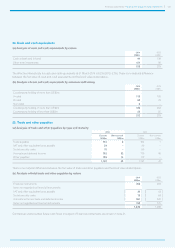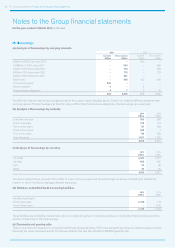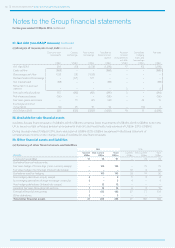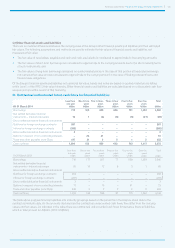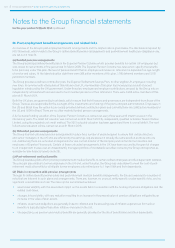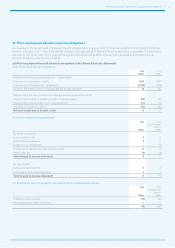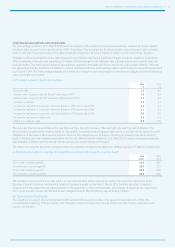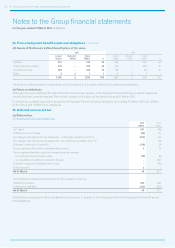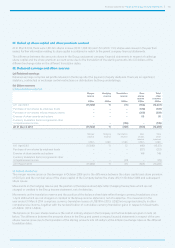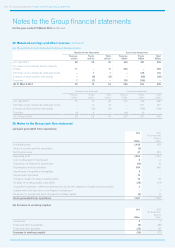Experian 2014 Annual Report Download - page 152
Download and view the complete annual report
Please find page 152 of the 2014 Experian annual report below. You can navigate through the pages in the report by either clicking on the pages listed below, or by using the keyword search tool below to find specific information within the annual report.
Financial statements • Notes to the Group financial statements
Notes to the Group financial statements
for the year ended 31 March 2014 continued
148
33. Post-employment benefit arrangements and related risks
An overview of the Group’s post-employment benefit arrangements and the related risks is given below. The disclosures required by
IAS 19 (revised), which relate to the Group’s defined benefit pension arrangements and post-retirement healthcare obligations only,
are set out in note 34.
(a) Funded pension arrangements
The Group’s principal defined benefit plan is the Experian Pension Scheme which provides benefits for certain UK employees but
was closed to new entrants in the year ended 31 March 2009. The Experian Pension Scheme has rules which specify the benefits
to be paid and, under this plan, the level of pension benet that an employee will receive on retirement is dependent on age, length
of service and salary. At the latest valuation date there were 269 active members of this plan, 1,780 deferred members and 3,155
pensioner members.
The Group provides a defined contribution plan, the Experian Retirement Savings Plan, to other eligible UK employees including
new hires. In common with other plans of this nature in the UK, membership of this plan has increased as a result of recent
legislation introduced by the UK government. Under this plan, employee and employer contributions are paid by the Group into an
independently administered fund and used to fund member pensions at their retirement. There were 3,286 active members of this
plan at 31 March 2014.
Both the UK plans are governed by trust deeds which ensure that their finances and governance are independent from those of the
Group. Trustees are responsible for the oversight of the investments and funding of the plans and plan administration. Employees in
the US and Brazil have the option to join locally provided defined contribution plans and currently there are 3,892 active members in
the US and 1,608 in Brazil. There are no other material funded pension arrangements.
A full actuarial funding valuation of the Experian Pension Scheme is carried out every three years with interim reviews in the
intervening years. The latest full valuation was carried out as at 31 March 2013 by independent, qualified actuaries, Towers Watson
Limited, using the projected unit credit method. The 2013 actuarial valuation has been agreed and there is a small deficit. The next
full actuarial valuation will be carried out as at 31 March 2016.
(b) Unfunded pension arrangements
The Group has had unfunded pension arrangements in place for a number of years designed to ensure that certain directors
and senior managers in the UK who are affected by the earnings cap are placed in broadly the same position as those who are
not. Additionally there are unfunded arrangements for one current director of the Company and certain former directors and
employees of Experian Finance plc. Certain of these unfunded arrangements in the UK have been secured by the grant of charges
to an independent trustee over an independently managed portfolio of marketable securities owned by the Group and reported as
available-for-sale financial assets (note 28).
(c) Post-retirement medical benefits
The Group operates plans which provide post-retirement medical benefits to certain retired employees and their dependant relatives.
The principal plan relates to former employees in the UK and, under this plan, the Group has undertaken to meet the cost of post-
retirement medical benefits for all eligible former employees who retired prior to 1 April 1994 and their dependants.
(d) Risks in connection with pension arrangements
Through its defined benefit pension plans and post-retirement medical benefits arrangements, the Group is exposed to a number of
risks that are inherent in such plans and arrangements. There are, however, no unusual, entity-specific or plan-specific risks, and no
significant concentrations of risk. The risks can be summarised as follows:
• asset value volatility, with the associated impact on the assets held in connection with the funding of pension obligations and the
related cash flows.
• changes in bond yields, with any reduction resulting in an increase in the present value of pension obligations mitigated by an
increase in the value of plan assets.
• inflation, as pension obligations are generally linked to inflation and the prevailing rate of inflation experienced for medical
benefits is typically higher than other inflation measures in the UK.
• life expectancy, as pension and medical benefits are generally provided for the life of beneficiaries and their dependants.



